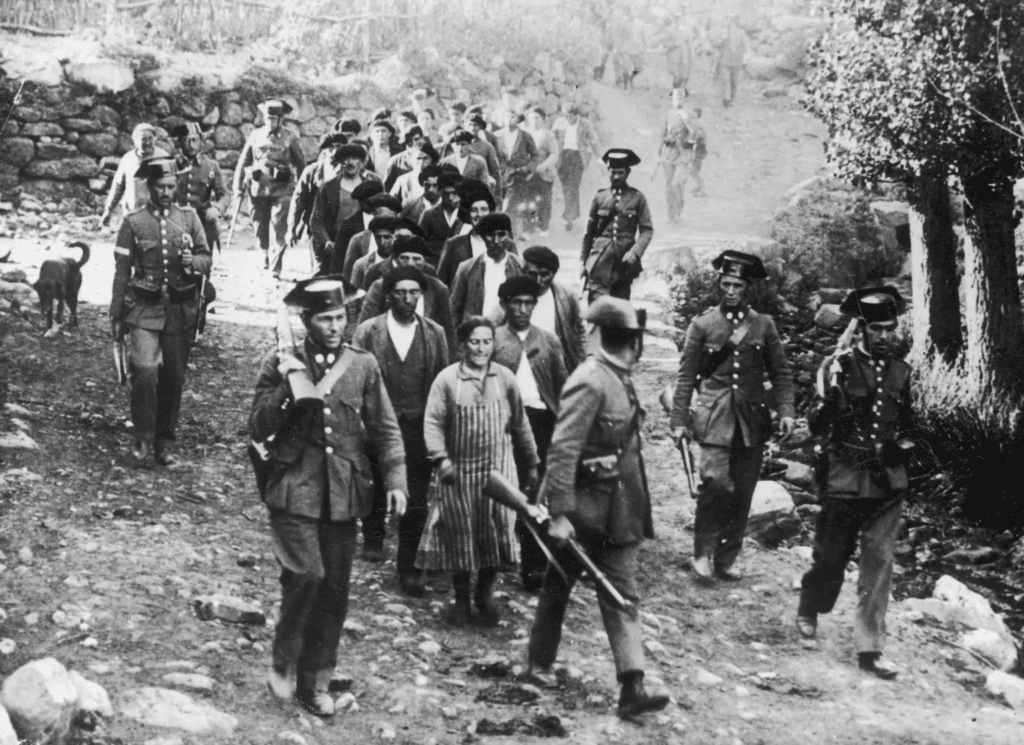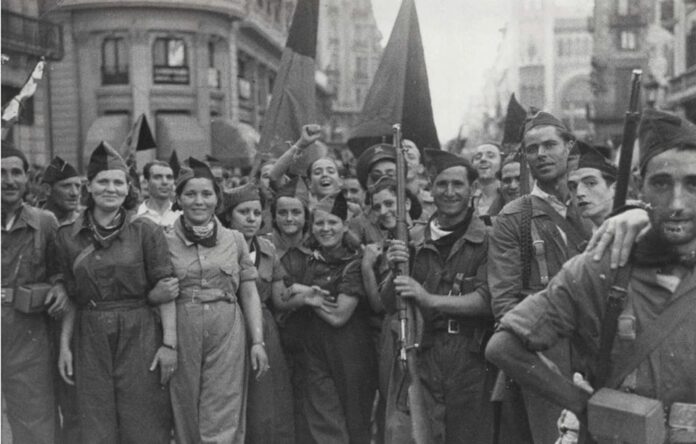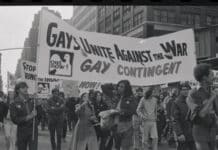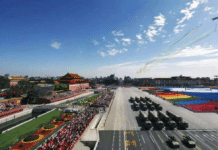The Spanish Revolution of 1931–1939 is one of the greatest events in working-class history in the twentieth century. Heroic Spanish workers rose up against an attempted coup in 1936 by the army, commanded by the reactionary fascist General Francisco Franco.
Cormac Kelly, Socialist Alternative (ISA in England, Wales and Scotland)
The Spanish Revolution of 1931–1939 is one of the greatest events in working-class history in the twentieth century. Heroic Spanish workers rose up against an attempted coup in 1936 by the army, commanded by the reactionary fascist General Francisco Franco, a man who had already crushed miners on strike in the Asturias two years earlier.
The victory of fascism in Italy and Germany made the struggle in Spain critical. Workers all over the world knew the terrible consequences of fascist victory. In Italy, the Blackshirts, organised by Benito Mussolini, armed and financed by the capitalists, crushed the working class after the failure of the revolutionary factory occupations of 1920.
Workers face defeat in Germany
In Germany, fascism, in the form of Hitler’s Nazis, was initially used by the bosses to crush the workers movement. Finance capital poured huge resources into Hitler’s movement and its SA Stormtroopers to attack the enormously powerful German workers movement. After the Wall Street Crash of 1929 and the Great Depression, the ruling class had come to the conclusion that only the destruction of the organisations of the workers would save their system and stave off the threat of revolution.
With the criminal failure of the German Communist Party and the Social Democrats to effectively fight the fascists, and with the full compliance of the bourgeois state, Hitler came to power in 1933. Leon Trotsky (co-leader of the Russian Revolution alongside Lenin) carefully analysed the development of fascism during its rise in the 1920/30s. He argued that fascism was based on a mass movement of exploited middle class and “declassed” elements in society (those in the most desperate conditions), to destroy all forms of working-class organisation.
Trotsky pointed out that the ruling class turned to fascism as a result of the huge crisis of their system, and where they could only govern on the basis of savage attacks on working-class living standards that would be impossible on the basis of parliamentary democracy.
The victory of fascism in Italy, Germany and Spain was only made possible by the defeats of the revolutions in these countries. The mistakes, treachery and even counter — revolutionary activities of the reformist and Stalinist leaders led to the working classes of these countries paying a terrible price.
In Germany the KPD under the direction of Stalin declared that the biggest workers party, the Social Democrats, were actually “Social Fascists” and refused to combine with them in a United Front to oppose the Nazis. A United Front would bring all workers together in a common struggle to defend the interests of the working class against the bourgeoisie — in this case to defeat the Nazis.
Social Democrats, communists, and even non — aligned workers could have also been be drawn into the Front in the defence of the working class. The KPD rejected this tactic, and the reformist leaders naturally had no interest in a serious struggle against the capitalists or their Nazi hirelings, and as a result the immobilised workers movement was destroyed, with the leadership of the trade unions and left political parties shot or imprisoned.
Spain in crisis
For centuries Spain was backward and peasant based. Marx described the country as being in ‘inglorious decay’. It was ruled by a corrupt, degenerate elite, around a monarchy totally incapable of bringing about a bourgeois revolution. In the countryside there was a large workforce of poor, half-starved landless day labourers who survived on a pittance, and 80% of women were illiterate.
However rapid industrialisation in the twentieth century had created a small but significant proletariat (working class) who were to be the backbone of the struggle — particularly in Catalonia and the Basque country. Bourgeois historians describe the events in Spain in the 1930s as a civil war, but in reality it was also a revolution. In 1931 the King was forced to abdicate, replaced by a republican, but right-wing and pro-capitalist government.
Huge strikes followed as expectations soared and in turn the government attempted to suppress them. The far-right general Franco brutally suppressed the Asturian miners uprising of 1934, killing over 5000 miners and imprisoning 30,000. This was a dress rehearsal for the civil war two years later. The miners, whilst defeated, hid their weapons — they were aware that they would be needed!

In 1936 a Popular Front coalition of workers and bourgeois parties came to power. This electoral victory was a trigger for the Spanish masses. They did not wait for the new government to enact reforms. Fascist bosses were driven out of factories, and a 44-hour maximum working week introduced with no loss of pay. Land and factories were occupied. Sacked and victimised workers got their jobs back. 30,000 political prisoners were released from jail including all those imprisoned after the Asturian uprising.
The Popular Front soon undermined this audacious action of the working class. A combined bourgeois and reformist government obstructed the carrying out of revolution, in the absence of a mass revolutionary party — a key reason for the defeat of the Spanish workers. Leon Trotsky was later to describe the Popular Front as “a strike breaking conspiracy.”

As the USSR was supplying the government with arms, the Stalinist Spanish Communist Party (PCE) were able to leverage power. They put forward a “stages” theory, arguing that it was necessary to develop capitalism in economically backward countries such as Spain before later passing on to the next stage of the socialist revolution. According to the PCE it was essential to win over ‘progressive’ capitalists and side-line the demands of the working class to defeat Franco. Alliances with sections of the bourgeoisie had to be made and the socialist revolution could wait.
The permanent revolution
In an under-developed country like Spain there was a weak ruling class, with little ability to solve the problems of land ownership because the capitalists themselves either are linked to the land owning class or are the land owning class and were in hock to the biggest imperialist powers. The solution was to collectivise the land. Three out of four people in Spain were peasants desperate for land reform. In the revolution the Popular Front government was not going to carry out the task of land reforms so the working class and poor did it for themselves.
The peasants and working class collectivised the land and took over the factories, going on to run them. However, weakening the revolution was the lack of an overall national coordination of workers committees which often were made up of political parties rather than directly elected workers’ representatives. Nor, unlike the Bolsheviks in October 1917 was there a mass revolutionary party to give leadership to the revolution.
Adding to the mistakes of the Stalinists was the confused role of the anarchists. In Catalonia the anarcho-syndicalist trade union, the CNT, had a mass base made up of determined class fighters. The anarchists rejected the task of taking power as a matter of principle in the opening weeks of the revolution, only for them to join the Popular Front government as ministers later. They threw away a golden opportunity to complete the revolution in Catalonia. Whilst the leadership were in their ideological ivory tower, their fighting rank and file members were building the basis for working-class power across Aragon.
They compounded this mistake in the ‘May Days’ of 1937 when the Government, led by the Stalinist security forces, attempted to take over the telephone exchange controlled by the CNT and revolutionary workers in Barcelona. An infuriated Catalan working class, which had been nursing months of grievances against the Communists/Liberal government, took to the streets. The joke went “Vote Communist and save capitalism”. Within hours, barricades were raised all over the city. The insurrection spread beyond Barcelona across Catalonia, and into Aragon, where rank and file anarchists were willing to fight to defend the revolution.

The PCE, willing to use force in the middle of the war with Franco to crush the anarchist militias, were guilty of counter-revolution. The anarchist leadership told the CNT workers to lay down their arms and go home so that negotiations could start. Quickly the city was seized by 6,000 police. Following on in January 1938, many were killed in a purge and 15,000 revolutionaries were imprisoned by the Republican government.
The POUM
In 1935, the Workers Party of Marxist Unification (POUM) was created by Trotskyists and other socialists opposed to the Stalinism of the PCE and was strong in Catalonia and Valencia. Its leader Andres Nin said he was influenced by the ideas of Leon Trotsky but if only he had taken the advice and guidance of Trotsky, the revolution in Spain may well have been successful. Instead the party was opportunistic, taking a position of arguing for revolution in the future while being reformist in practice and everyday activity.
The party’s membership exploded from 1,000 to 70,000 in 1936 with its appeal to workers dissatisfied with both the anarchists and the Stalinists. Nin was frequently advised in letters from Leon Trotsky but replied that the Spanish Revolution was unique, that events in Italy and Germany were irrelevant to the struggle and so the party ended up with no clear political programme at all. The POUM had no idea how the working class could take and consolidate power, and located itself marginally to the left of the parties of the Popular Front. Its position caught halfway between reformism and genuine Marxism paralysed it from any real decisive activity when the opportunity for revolution came.
In the ‘May Days’ of 1937 the workers held the streets of cities and towns across Catalonia, having learned from the mistakes of 1936. But the POUM failed to give independent revolutionary leadership to the angry and militant masses desperate to end the rule of the Popular Front and defeat the fascists. This would have involved helping the working class take power in these regions with the perspective of then spreading a real workers’ revolution across Spain and beyond. Instead, the POUM yet again orientated to other groups on the Left.

This included, in particular, the anarchists. Nin was caught up in the Stalinist purge, being arrested, viciously tortured and then murdered by agents of the Soviet secret police. After the revolutionary upsurge was crushed, the POUM suffered terrible repression and was destroyed, with the Stalinists the most enthusiastic persecutors.
The failure of leadership
In the Spanish Revolution between 1931 and 1939 numerous varieties of left party (except the Bolshevik type) had an opportunity to test their ideas and strategies in the cauldron of revolution and they all failed. Trotsky, in his remarkable article, ‘The Class, the Party, and the Leadership’, takes up those who argued that the working class in Spain did not take power because they were not ready to do so.
It was the Spanish masses that rose and armed themselves to fight the fascist uprising in 1936. It was the Catalan working class who rose in the ‘May days’ of 1937. Where were the parties of the left? “What does the ‘immaturity’ of the proletariat signify in this case?” asks Trotsky. It is crystal clear that despite the courageous struggles initiated by the masses, the coalition of reformist socialists, Stalinists, Anarchists, and the POUM with the bourgeoisie stood in the way of a real victory.
Through its connection to the Soviet Union, the PCE claimed the authority of the only successful proletarian revolution in history and were capable of getting arms to Spain. But alongside the USSR itself, the PCE had degenerated into a counter-revolutionary Stalinist monstrosity.
The anarchists admitted that the CNT wanted to seize power in May 1937 and could have done so without difficulty, but their leaders refused to do so.
The POUM had a proletarian revolutionary membership but, instead of leading an independent struggle for workers’ power, vacillated and acted as a brake upon the struggle for independent working-class action.
For Leon Trotsky the lessons of the revolution were rich. He was in awe of the fighting spirit of the Spanish working class, stating they could have carried out ten revolutions. Studying this revolution is not an academic exercise. Victory would have meant almost certainly no Second World War, the spread of socialism to the whole of Europe and beyond and the defeat of Nazism and Stalinism before 1940. From the lessons of Spain, the working class can learn who is and who is not their ally, how to fight fascism and the importance of the mass revolutionary party.




